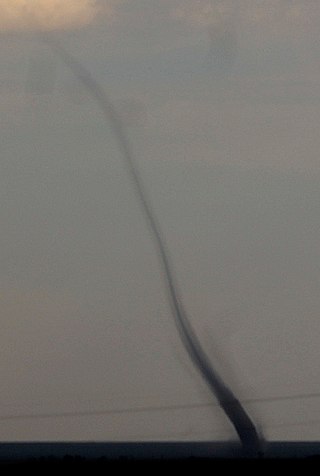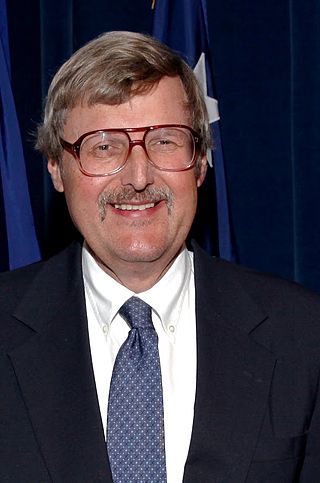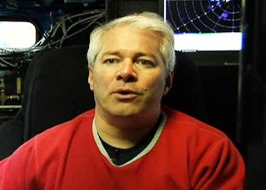Related Research Articles

A tornado is a violently rotating column of air that is in contact with both the surface of the Earth and a cumulonimbus cloud or, in rare cases, the base of a cumulus cloud. It is often referred to as a twister, whirlwind or cyclone, although the word cyclone is used in meteorology to name a weather system with a low-pressure area in the center around which, from an observer looking down toward the surface of the Earth, winds blow counterclockwise in the Northern Hemisphere and clockwise in the Southern. Tornadoes come in many shapes and sizes, and they are often visible in the form of a condensation funnel originating from the base of a cumulonimbus cloud, with a cloud of rotating debris and dust beneath it. Most tornadoes have wind speeds less than 180 kilometers per hour, are about 80 meters across, and travel several kilometers before dissipating. The most extreme tornadoes can attain wind speeds of more than 480 kilometers per hour (300 mph), are more than 3 kilometers (2 mi) in diameter, and stay on the ground for more than 100 km.

Tetsuya Theodore Fujita was a Japanese-American meteorologist whose research primarily focused on severe weather. His research at the University of Chicago on severe thunderstorms, tornadoes, hurricanes, and typhoons revolutionized the knowledge of each. Although he is best known for creating the Fujita scale of tornado intensity and damage, he also discovered downbursts and microbursts, and was an instrumental figure in advancing modern understanding of many severe weather phenomena and how they affect people and communities, especially through his work exploring the relationship between wind speed and damage.

A wall cloud is a large, localized, persistent, and often abrupt lowering of cloud that develops beneath the surrounding base of a cumulonimbus cloud and from which tornadoes sometimes form. It is typically beneath the rain-free base (RFB) portion of a thunderstorm, and indicates the area of the strongest updraft within a storm. Rotating wall clouds are an indication of a mesocyclone in a thunderstorm; most strong tornadoes form from these. Many wall clouds do rotate; however, some do not.

A hook echo is a pendant or hook-shaped weather radar signature as part of some supercell thunderstorms. It is found in the lower portions of a storm as air and precipitation flow into a mesocyclone, resulting in a curved feature of reflectivity. The echo is produced by rain, hail, or even debris being wrapped around the supercell. It is one of the classic hallmarks of tornado-producing supercells. The National Weather Service may consider the presence of a hook echo coinciding with a tornado vortex signature as sufficient to justify issuing a tornado warning.

Landspout is a term created by atmospheric scientist Howard B. Bluestein in 1985 for a kind of tornado not associated with a mesocyclone. The Glossary of Meteorology defines a landspout as

The rear flank downdraft (RFD) is a region of dry air wrapping around the back of a mesocyclone in a supercell thunderstorm. These areas of descending air are thought to be essential in the production of many supercellular tornadoes. Large hail within the rear flank downdraft often shows up brightly as a hook on weather radar images, producing the characteristic hook echo, which often indicates the presence of a tornado.
Joseph G. Galway, was an American meteorologist pioneering in the fields of severe convective storm forecasting and research. He was one of the first forecasters for the Severe Local Storms Unit and the National Severe Storms Forecast Center, and developed widely used synoptic predictors associated with severe thunderstorms and tornadoes, such as the jet streak and lifted index.

Ronald William Przybylinski was an American meteorologist who made important contributions to understanding of bow echoes, mesovortices, related quasi-linear convective system (QLCS) structures and processes, as well as QLCS related tornadoes. He also was an expert on technical aspects of weather radar and applications to both operational meteorology and research.
Neil Burgher Ward was an American meteorologist who is credited as the first scientific storm chaser, developing ideas of thunderstorm and tornado structure and evolution as well as techniques for forecasting and severe weather intercept. He also was a pioneering developer of physical models of tornadoes, first at his home, then at the National Severe Storms Laboratory (NSSL) in Norman, Oklahoma. He significantly furthered the modern scientific understanding of atmospheric vortices, particularly tornadoes.

Joshua Michael Aaron Ryder Wurman is an American atmospheric scientist and inventor noted for tornado, tropical cyclone, and weather radar research.
On May 24–25, 1957, a tornado outbreak primarily affected the Western High Plains, Central Great Plains, and Central Oklahoma/Texas Plains of the United States. 45 tornadoes touched down over the area, most of which took place across northern and western Texas, in addition to southern Oklahoma. Overall activity initiated over eastern New Mexico and spread northeastward as far as southwestern Wisconsin. The strongest tornado, which occurred in southern Oklahoma on May 24, was assigned a rating of F4 near Lawton. Anomalously, some tornadoes touched down during the early morning hours, rather than late afternoon or early evening, when daytime heating typically peaks.
On March 21–22, 1932, a deadly tornado outbreak struck the Midwestern and Southern United States. At least 38 tornadoes—including 27 killers and several long-lived tornado families—struck the Deep South, killing more than 330 people and injuring 2,141. Tornadoes affected areas from Mississippi north to Illinois and east to South Carolina, but Alabama was hardest hit, with 268 fatalities; the outbreak is considered to be the deadliest ever in that U.S. state, and among the worst ever in the United States, trailing only the Tri-State tornado outbreak in 1925, with 747 fatalities, and the Tupelo–Gainesville outbreak in 1936, with 454 fatalities. The 1932 outbreak is believed to have produced 10 violent tornadoes, eight of which occurred in Alabama alone.

The Teton–Yellowstone tornado was a rare high-altitude tornado which occurred on July 21, 1987, in the U.S. state of Wyoming. Rated at F4 on the Fujita scale, it remains the strongest tornado ever recorded in the state and the only recorded F4/EF4 tornado in Wyoming history. The tornado cut through a 39.2-kilometre (24.4 mi)-long and 2.5-kilometre (1.6 mi)-wide swath of the Teton Wilderness and Yellowstone National Park, crossing the Continental Divide. Damage occurred at elevations ranging from 8,500 to 10,000 feet, making it the highest-altitude violent tornado recorded in the United States. At the time, it was the highest-elevation tornado known, since surpassed by several others, including a 2004 tornado above 12,000 feet in California's Sequoia National Park. While no human fatalities or injuries occurred, an estimated one million trees were felled by the tornado. The tornado damage was originally thought to be the result of strong thunderstorm straight-line winds until the area was surveyed by University of Chicago severe weather meteorologist Ted Fujita and his colleagues, who published a paper in 1989 surveying the tornado's path and discussing its meteorological character.
In the early morning hours of April 4, 1981, an unusual and deadly anticyclonic F4 tornado struck West Bend, Wisconsin. It killed three people, and injured another 53. The tornado was largely unexpected and the storm that produced it did not display features of a typical severe storm. Because of this, the National Weather Service issued only a Severe Thunderstorm Warning prior to the tornado, causing local law enforcement to not sound the tornado sirens in time for residents to take shelter.
On April 19–21, 1920, a multi-day severe weather event affected the Southeastern United States. The most intense portion of the outbreak occurred on the morning of April 20. At least seven tornadoes affected the American U.S. states of Mississippi, Alabama, and Tennessee, six of them rated violent F4s on the Fujita scale. The tornado outbreak killed at least 243 people.
Jonathan M. "Jon" Davies is an American meteorologist, storm chaser, and author. An operational meteorologist, Davies is a weather forecaster and is known for his mesoscale meteorology research related to tornadoes and convective storms. He is a major discoverer of the minisupercell thunderstorm now often referred to as a low-topped supercell, pioneered significant research on tornado environments including on cold-core situations and the importance of low-level buoyancy in some deceptively low-CAPE tornado situations, and produced important case studies.
Leslie R. Lemon was an American meteorologist bridging research and forecasting with expertise in weather radar, particularly regarding severe convective storms. Lemon was, along with Charles A. Doswell III, a seminal contributor to the modern conception of the supercell which was first identified by Keith Browning, and he developed the Lemon technique to estimate updraft strength and thunderstorm organization also as a continuation of Browning's work.
On April 18–20, 1880, a tornado outbreak impacted the Midwestern United States, producing numerous strong tornadoes, killing at least 166 people, and injuring more than 516 others. The outbreak generated five violent tornadoes, including three long-tracked F4 tornadoes in Missouri that killed at least 144 people. Two of the tornadoes followed parallel paths and occurred simultaneously near Springfield, one of which devastated the town of Marshfield, causing 92 fatalities there. Other deadly, intense tornadoes occurred in the Great Lakes region and in Arkansas, including another F4 tornado that destroyed a third of El Paso, Arkansas, killing four or more people.

Project NIMROD was a meteorological field study of severe thunderstorms and their damaging winds conducted by the National Center for Atmospheric Research (NCAR). It took place in the Greater Chicago area from May 15 to June 30, 1978. Data collected was from single cell thunderstorms as well as mesoscale convective systems, such as bow echoes. Using Doppler weather radars and damage clues on the ground, the team studied mesocyclones, downbursts and gust fronts. NIMROD was the first time that microbursts, very localized strong downdrafts under thunderstorms, were detected; this helped improve airport and public safety by the development of systems like the Terminal Doppler Weather Radar and the Low-level windshear alert system.
References
- ↑ "Dr. Greg Forbes: Tornado and Severe Weather Expert". Company Info. The Weather Channel. Retrieved 2014-05-05.
- ↑ "Bulletin Board." Latrobe, Pennsylvania: Latrobe Bulletin, October 4, 2003, p. 4 (subscription required).
- ↑ Forbes, Gregory S. (July 1981). "On the Reliability of Hook Echoes as Tornado Indicators" (pdf). Monthly Weather Review . 109 (7): 1457–1466. doi: 10.1175/1520-0493(1981)109<1457:OTROHE>2.0.CO;2 . ISSN 1520-0493 . Retrieved May 22, 2020.
- ↑ "Dr. Greg Forbes". Archived from the original on 18 March 2016. Retrieved 3 March 2012.
- 1 2 "Dr. Greg Forbes". www.facebook.com. Retrieved 2018-07-08.
- ↑ Samenow, Jason (May 1, 2014). "Weather Channel's Greg Forbes diagnosed with cancer, but "prognosis is good"". Capital Weather Gang: The inside scoop on weather in the D.C. area and beyond. The Washington Post. Retrieved May 5, 2014.
- ↑ "I got word from my doctor this afternoon..." Facebook: User twcdrforbes. December 23, 2014.
- ↑ "We wanted to share that Dr. Greg Forbes..." Facebook: User TheWeatherChannel. January 12, 2017.